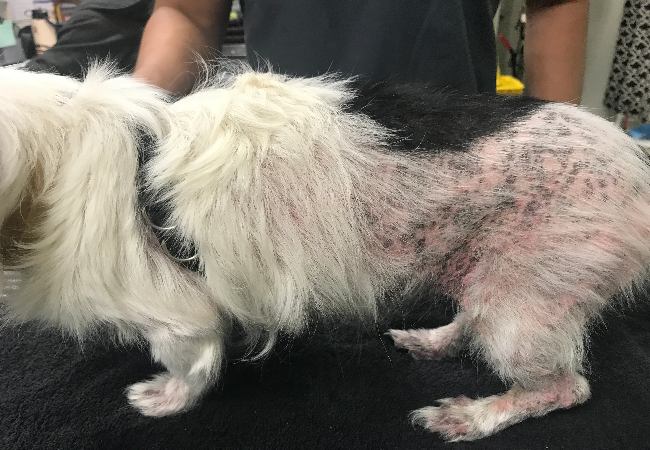Veterinary Guide to Flea Allergy Dermatitis in Dogs (2025)🐶

In this article
Veterinary Guide to Flea Allergy Dermatitis in Dogs (2025)🐶
By Dr. Duncan Houston BVSc
🔍 Introduction
Flea allergy dermatitis (FAD) is the most commonly diagnosed allergic skin disease in dogs, triggered by immune hypersensitivity to proteins in flea saliva—sometimes, just one bite is enough. It causes intense itching, hair loss, and secondary infections. Early detection and a comprehensive control plan are vital in restoring comfort and skin health. 🛡️
💡 Causes & Immune Response
- An allergic reaction to flea saliva proteins—immune sensitization often results in severe itching from just a few bites.
- Dogs with existing skin allergies (e.g., atopic dermatitis) are more predisposed.
- FAD outbreaks peak in summer or warm climates but can persist year-round.
🚨 Clinical Signs
- Severe pruritus—constant scratching, chewing, biting, or rubbing.
- Hair loss, scabs, crusts, papules—especially across the “flea triangle” (lower back, base of the tail, inner hind legs).
- Secondary pyoderma or yeast infections—hot spots, redness, pustules may develop.
- In severe infestations, anemia may occur, especially in puppies or immunocompromised dogs.
🔬 Diagnosis
- Based on clinical signs and location of lesions.
- Finding live fleas or flea dirt confirms infestation, though in FAD, even a few fleas can cause signs.
- In complex cases, intradermal tests or flea saliva-specific IgE assays may help, though tests are ~80% sensitive.
🛠 Treatment: Triple Approach
-
Rapid flea elimination:
- Initiate fast-acting flea control (oral/topical) like fluralaner (Bravecto), pyriprole, or selamectin.
- Treat all household pets and use environmental products to eliminate eggs/larvae.
-
Relieve inflammation and itching:
- Short-course corticosteroids for immediate relief.
- Targeted therapies: Apoquel (oclacitinib) or Cytopoint (lokivetmab) offer itch control with fewer side effects.
- Antihistamines (e.g., diphenhydramine) may offer adjunctive comfort.
-
Treat secondary infections:
- Antibiotics (e.g., cephalexin, Clavamox) or medicated shampoos for bacterial or yeast infections.
📈 Follow-Up & Monitoring
- Improvement often seen within days after flea elimination and medication.
- Reevaluate in 2–4 weeks to adjust anti-itch dosing and confirm control.
- Monitor the environment—clean bedding, vacuum carpets, treat outdoor areas regularly.
🛡 Prevention & Long-Term Care
- Year-round flea control tailored to your region and pet.
- Maintain environment: regular vacuuming, washing bedding at ≥60 °C, treat yards as needed.
- Supplement diets with omega-3s or vitamin A to support skin barrier health.
- Keep pets groomed and routinely checked for signs of fleas or emerging skin lesions.
🔧 Owner Tools & Support
- Ask A Vet App: 24/7 help on flea identification, medication choice, and infection management 📱
✅ Final Thoughts
Flea allergy dermatitis causes frustrating and painful itch in dogs, but rapid flea elimination, itch control, infection treatment, and rigorous prevention restore comfort and protect the skin. With a coordinated, year‑round strategy—and tools like Ask A Vet, pet parents can confidently keep FAD in check throughout 2025 and beyond. 🐾❤️
Download the Ask A Vet app today for expert advice on flea control, anti‑itch therapies, and skin wellness tracking. 📱💡






